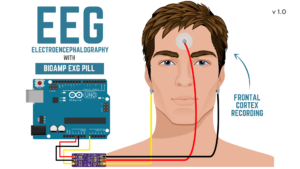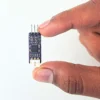BioAmp EXG Pill is a one-of-a-kind pill-size chip that can record publication-grade biopotential signals from your body, be it from the heart (ECG), brain (EEG), eyes (EOG), and muscles (EMG). It is a powerful analog-front-end (AFE) biopotential signal-acquisition board that can be paired with any 3.3/5V microcontroller unit (MCU) or single-board computer (SBC) with an analog-to-digital converter (ADC) such as Arduino UNO & Nano, Adafruit QtPy, STM32 Blue Pill, BeagleBone Black, and Raspberry Pi Pico, to name just a few. It also works with any dedicated ADC, like the Texas Instruments ADS1115 and ADS131M0x, among others.

What makes it different?
- Record publication-quality biopotential signals like ECG, EMG, EOG, or EEG
- The small size (25.4 x 10.0mm) allows easy integration into mobile and space-constrained projects
- Powerful noise rejection makes it usable even when the device is close to the AC mains supply
- Pair it with any MCU with an ADC. The older versions are by default compatible with 5V, but you can make it compatible with 3.3V devices as well using a voltage divider. The 2025 Edition of BioAmp EXG Pill is compatible with both 3.3/5V development boards.
- Configure the gain, bandpass filter, and electrode count according to your requirements.
Features & Specifications
- Input Voltage: 3.3/5 V
- Input Impedance: 10^12 Ω
- Compatible Hardware: Any ADC input
- Biopotentials: ECG EMG, EOG, or EEG (configurable bandpass) | By default configured for EEG and EOG
- No. of channels: 1
- Electrodes: 2 or 3 (configurable) | By default configured for 3 electrodes
- Dimensions: 25.4 x 10.0 mm
- Open Source: Hardware + Software
Board Pinout Diagrams:


BioAmp EXG Pill is fully configurable as you can:
- Increase the gain of the instrumentation amplifier by using a 0603 resistor at R6. Decrease gain and configure the bandpass filter by using 0603 parts at R12 and C5. Band limiting is very useful for EOG and EEG recording. Also, the signal sometimes clips while recording ECG with electrodes very close to the heart. Creating a solder jumper for a band-pass filter helps with that. By default, BioAmp EXG Pill is configured to record EEG and EOG but you can bridge the pads (below bandpass) with solder to make it configurable for EMG and ECG.
- The normal method of operation for best-quality signal amplification is to use 3 electrodes by default, but you can bridge the pads (below electrodes) to make it configurable for 2 electrodes. The 2-electrode mode is specifically included for projects like heart (ECG) patches for HRV. It’s only supposed to be used with a battery-operated setup and is quite prone to high interference noise due to a lack of proper reference on the body (This option is not recommended for most operations)
Recording and Visualizing ECG, EMG, EOG, and EEG
1. Electromyography (EMG)
Electromyography (EMG) is a technique for evaluating and recording the electrical activity produced by skeletal muscles. EMG is also used as a diagnostic procedure to assess the health of muscles and the nerve cells that control them (motor neurons). EMG results can reveal nerve dysfunction, muscle dysfunction, or problems with nerve-to-muscle signal transmission.
To record the EMG signals, the electrode placements and connections with Arduino Uno (or any other ADC of your choice) should be as per the picture given below.

In this case, we have targeted the ulnar nerve on the forearm but you can target any other muscle as well, just make sure to place the reference electrode far from positive and negative electrodes, preferably on a bony part to have less interference from other muscles.
Demo Video:
2. Electrocardiography (ECG)
Electrocardiography (ECG) is the process of producing an electrocardiogram (ECG or EKG). It is a graph of voltage vs time of the electrical activity generated in the heart which can be detected using electrodes placed on the skin. These electrodes detect the small electrical changes that are a consequence of cardiac muscle depolarization followed by repolarization during each cardiac cycle (heartbeat).
The images below show electrode placements for lead 1 ECG recording and hand EKG/ECG recording, respectively.

Demo Video:
3. Electrooculography (EOG)
Electrooculography (EOG) is a technique for measuring the corneo-retinal standing potential between the human eye’s front and back. The resulting signal is called EOG.
To measure eye movement, pairs of electrodes are typically placed above and below the eye (for vertical movement recording) or to the left and right of the eye (for horizontal movement recording). Suppose the eye moves from the center toward one of the two electrodes. In that case, this electrode “sees” the positive side of the retina, and the opposite electrode “sees” the negative side of the retina. Consequently, a potential difference occurs between the electrodes. Assuming the resting potential is constant, the recorded potential measures the eye’s position.
The EOG signal (horizontal movement) recorded with BioAmp EXG Pill can be found below:


Demo Video:
4. Electroencephalography (EEG)
Electroencephalography (EEG) is an electrophysiological monitoring method to record electrical activity on the scalp. During the procedure, electrodes consisting of small metal discs with thin wires are pasted onto your scalp. The electrodes detect tiny electrical charges that result from the activity of your brain cells which are then amplified to appear on the computer screen. It is typically non-invasive, with the electrodes placed along the scalp.
The images below show the electrode placements to record EEG from the Pre-Frontal Cortex part of the brain.

We also tried recording EEG signals from the Visual Cortex part of the brain (as shown in the video given below) and the results were really good as we were getting clean 10Hz signals whenever John was closing his eyes.
Use the Chords Software suite to visualize the biopotential signals
1. Chords-Web: Chords-Web is an open-source web application designed for real-time signal visualization, particularly tailored for bio-potential signals like EEG, EMG, ECG, and EOG. This tool is an advanced alternative to the standard Arduino IDE serial plotter, offering enhanced functionality for students, researchers, and hobbyists.










Project ideas & tutorials
BioAmp EXG Pill is perfect for researchers, makers, and hobbyists looking for novel ways to sample biopotential data. It can be used for a wide variety of interesting biosensing projects, including:
1. Electromyography (EMG)
- Controlling a Prosthetic hand
- Controlling 3 DOF (Degree of Freedom) Robotic Arm
- Controlling a servo motor
- LED Bar Graph of EMG Potential
- Quantitative Analysis of physical therapy for palsy patients
2. Electrooculography (EOG)
- Drowsiness Detection
- Clicking photos by blinking your eyes
- Blink Detection
- Real-time game controllers
3. Electroencephalography (EEG)
- Recording Brain Waves from Visual Cortex
- Recording Brain Waves from Pre-Frontal Cortex
- Controlling LEDs via brain waves
4. Electrocardiography (ECG)
- Chest ECG Heart Beat Detection
- Hand EKG Heart Beat Detection
- Heart Rate activated RGB LED Controller (ECG)
- AI-assisted detection of congestive heart failure using CNN
- Heart-rate variability calculation to detect heart ailments
Documentation:
To get started, check out the complete BioAmp EXG Pill documentation.
In case of any queries, you can mail us at support@upsidedownlabs.tech







































electroboffin –
The only pill which I love the most and can spend any amount money to buy such more pills. Enjoying this pill a lot. Embedding ECG, EMG, EOG, etc. in any project is just a matter of couple of minutes. This “PILL” is “CHILL” ??
Aleksa –
It’s unbelievable how much possibilities it’s hiding in that small of a package! Absolutely enjoying it and recommending to anyone who wants to step into the world of DIY neuroscience!